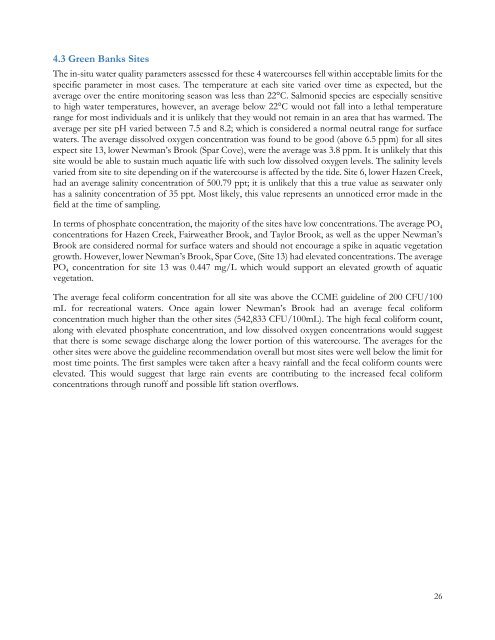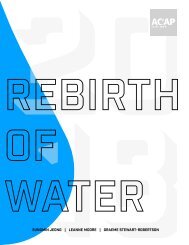Rebirth of Water Report 2016-2017
Marsh Creek, which is the largest watershed in greater Saint John, has been the recipient of centuries of untreated municipal wastewater deposition. Offensive odours, unsightly sanitary products and the threat posed by various human pathogens, resulting largely from the ~50 sewage outfalls in the lower reaches of Marsh Creek and the Saint John Harbour, have caused most residents to abandon the wellness of the watercourse. ACAP Saint John, a community-based ENGO and champion of the Harbour Cleanup project, has been conducting water quality monitoring and fish community surveys in the watershed since 1993 with the view towards someday restoring the ecological integrity of this forgotten natural asset.
Marsh Creek, which is the largest watershed in greater Saint John, has been the recipient of centuries of untreated municipal wastewater deposition. Offensive odours, unsightly sanitary products and the threat posed by various human pathogens, resulting largely from the ~50 sewage outfalls in the lower reaches of Marsh Creek and the Saint John Harbour, have caused most residents to abandon the wellness of the watercourse. ACAP Saint John, a community-based ENGO and champion of the Harbour Cleanup project, has been conducting water quality monitoring and fish community surveys in the watershed since 1993 with the view towards someday restoring the ecological integrity of this forgotten natural asset.
You also want an ePaper? Increase the reach of your titles
YUMPU automatically turns print PDFs into web optimized ePapers that Google loves.
4.3 Green Banks Sites<br />
The in-situ water quality parameters assessed for these 4 watercourses fell within acceptable limits for the<br />
specific parameter in most cases. The temperature at each site varied over time as expected, but the<br />
average over the entire monitoring season was less than 22°C. Salmonid species are especially sensitive<br />
to high water temperatures, however, an average below 22°C would not fall into a lethal temperature<br />
range for most individuals and it is unlikely that they would not remain in an area that has warmed. The<br />
average per site pH varied between 7.5 and 8.2; which is considered a normal neutral range for surface<br />
waters. The average dissolved oxygen concentration was found to be good (above 6.5 ppm) for all sites<br />
expect site 13, lower Newman’s Brook (Spar Cove), were the average was 3.8 ppm. It is unlikely that this<br />
site would be able to sustain much aquatic life with such low dissolved oxygen levels. The salinity levels<br />
varied from site to site depending on if the watercourse is affected by the tide. Site 6, lower Hazen Creek,<br />
had an average salinity concentration <strong>of</strong> 500.79 ppt; it is unlikely that this a true value as seawater only<br />
has a salinity concentration <strong>of</strong> 35 ppt. Most likely, this value represents an unnoticed error made in the<br />
field at the time <strong>of</strong> sampling.<br />
In terms <strong>of</strong> phosphate concentration, the majority <strong>of</strong> the sites have low concentrations. The average PO 4<br />
concentrations for Hazen Creek, Fairweather Brook, and Taylor Brook, as well as the upper Newman’s<br />
Brook are considered normal for surface waters and should not encourage a spike in aquatic vegetation<br />
growth. However, lower Newman’s Brook, Spar Cove, (Site 13) had elevated concentrations. The average<br />
PO 4 concentration for site 13 was 0.447 mg/L which would support an elevated growth <strong>of</strong> aquatic<br />
vegetation.<br />
The average fecal coliform concentration for all site was above the CCME guideline <strong>of</strong> 200 CFU/100<br />
mL for recreational waters. Once again lower Newman’s Brook had an average fecal coliform<br />
concentration much higher than the other sites (542,833 CFU/100mL). The high fecal coliform count,<br />
along with elevated phosphate concentration, and low dissolved oxygen concentrations would suggest<br />
that there is some sewage discharge along the lower portion <strong>of</strong> this watercourse. The averages for the<br />
other sites were above the guideline recommendation overall but most sites were well below the limit for<br />
most time points. The first samples were taken after a heavy rainfall and the fecal coliform counts were<br />
elevated. This would suggest that large rain events are contributing to the increased fecal coliform<br />
concentrations through run<strong>of</strong>f and possible lift station overflows.<br />
26


















